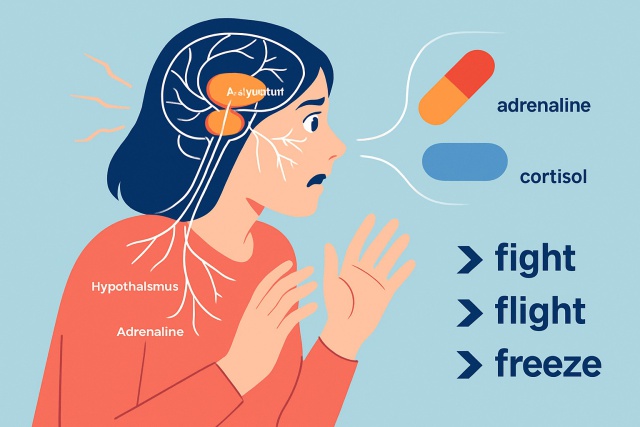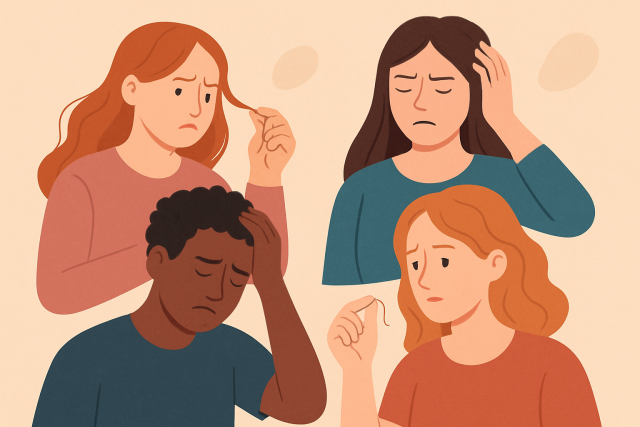
Understanding Obsession With Fire and Its Signs
Obsession with fire can be a perplexing and risky behavior. Learn what it means, why it happens, and...
This article dives into how to distinguish anxiety from lookalike conditions and explains why getting the diagnosis spot-on is key to a successful treatment journey.
Anxiety symptoms can show up in many ways and vary widely from one person to the next, making differential diagnosis for anxiety challenging as they often overlap with other mental or physical health issues.
Anxiety is a perfectly normal emotional response to stress or situations we perceive as threats—something we have all experienced at one point or another. Every so often, it decides to stick around and morph into a disorder that can really throw a wrench in the gears of daily life. It brings with it a slew of symptoms that affect both the mind and body.
Differential diagnosis is all about carefully teasing apart anxiety disorders from other medical or psychiatric conditions that wear similar symptoms on their sleeves.
"Getting the diagnosis of anxiety wrong often leads to treatments that miss the mark and stretch out a patient’s distress longer than necessary. From what I’ve seen, it’s absolutely key to roll up our sleeves and do a thorough differential diagnosis—digging beneath the surface to uncover any hidden issues—so we can provide care that truly makes a difference." — Dr. Helena Morse, Psychiatrist
Many medical and psychiatric conditions share symptoms that can easily be mistaken for anxiety or often tag along with it. This makes diagnosis quite the puzzle.
Several physical health issues can cause symptoms that mimic anxiety closely so getting a thorough medical check-up is key to the right diagnosis. Take endocrine problems like hyperthyroidism for instance. They often cause palpitations, sweating and jitters that can be mistaken for anxiety attacks. Neurological disorders such as epilepsy or Parkinson’s disease might cause anxiety-like symptoms because they disrupt brain function. Heart-related issues including arrhythmias can cause palpitations and chest discomfort often mistaken for anxiety. Thankfully, targeted tests like thyroid panels, ECGs and neurological exams help cut through the confusion.
| Medical Condition | Overlapping Symptoms | Distinguishing Features | Recommended Diagnostic Tests |
|---|---|---|---|
| Hyperthyroidism | Palpitations, sweating, nervousness | Noticeable weight loss, heat intolerance, and an enlarged thyroid gland that often sticks out | Thyroid function tests (TSH, T3, T4) |
| Cardiac arrhythmias | Palpitations, chest discomfort, dizziness | Irregular pulse with bouts of fainting that can really take you by surprise | ECG, Holter monitor, echocardiogram |
| Pheochromocytoma | Anxiety, headaches, sweating, fast heartbeat | Sudden spikes in blood pressure paired with raised catecholamine levels, the real giveaway | Plasma metanephrines, abdominal imaging |
| Epilepsy (Temporal lobe) | Sudden fear, déjà vu, altered awareness | EEG changes coupled with seizure activity, something EEG and MRI can catch quite well | EEG, MRI brain |
| Vitamin B12 deficiency | Fatigue, trouble thinking, mood shifts | Anemia and nerve damage in the limbs that often go hand in hand | Serum B12 levels, complete blood count |
| Hypoglycemia | Anxiety, sweating, shaking | Low blood sugar levels that tend to improve once you’ve eaten something | Blood glucose monitoring |
Psychiatric illnesses often come with symptoms that blur the lines with anxiety or appear alongside it. This can make nailing down a diagnosis quite the puzzle. Mood disorders like major depressive disorder and bipolar disorder frequently bring bouts of agitation or nagging feelings of anxiety. PTSD includes anxiety but is mainly defined by the haunting experience of reliving trauma under very specific diagnostic rules. Obsessive-compulsive disorder (OCD) involves intrusive thoughts and repetitive behaviors that stir up anxiety, making it distinct from generalized anxiety. Panic disorder causes sudden intense waves of anxiety with physical symptoms that can catch anyone off guard.
When it comes to properly sizing up anxiety symptoms clinicians usually lean on a thorough clinical assessment—think of it as the full toolbox: careful history-taking, a solid physical exam and some trusty validated screening tools.
Psychological assessments like the Hamilton Anxiety Rating Scale and Beck Anxiety Inventory provide straightforward ways to gauge just how intense anxiety is, while also pinpointing symptom patterns—tools that are really helpful for clinicians diagnosing and keeping track of progress. Medical tests should be ordered with care and only when clinical signs point in that direction, to rule out physical conditions that might be masquerading as anxiety. For example, thyroid function tests or ECGs come into play if there’s a hint of endocrine or heart trouble lurking beneath the surface. Neuroimaging or EEG might be called upon when neurological concerns are suspected.
Clinical scenarios reveal just how tricky it can be to nail down a diagnosis of anxiety disorders, especially since their symptoms often seem to blur into those of other conditions.
Careful effort and teamwork really hold the key when it comes to spotting anxiety versus other possible culprits.
Recent progress has sharpened our grasp of the neurobiological roots of anxiety, especially how brain circuits and neurotransmitter imbalances come into play. Emerging research is zeroing in on biomarkers like inflammatory markers and genetic profiles to improve differential diagnosis for anxiety, making it more precise and less of a shot in the dark. Neuroimaging techniques are improving at picking up distinct brain activity patterns that might help distinguish anxiety disorders from other mental or medical conditions. Meanwhile, advances in personalized medicine and digital health tools are opening promising new avenues for screening, monitoring and tailoring treatment that could shake up how anxiety is managed in clinical settings.
"Diagnosing anxiety is gradually shifting toward a blend of biological markers, cutting-edge neuroimaging, and digital phenotyping. The goal here is to craft treatments that feel more tailored and timely—moving well past the traditional symptom-based boxes we’ve relied on for far too long." — Dr. Samuel Greene, Neuroscientist
Anxiety and conditions like hyperthyroidism often share symptoms such as a rapid heartbeat and sweating. What usually sets medical causes apart are clues like unexpected weight loss or feeling overly sensitive to heat in hyperthyroidism. Blood tests that check your thyroid and a thorough physical exam can help clear things up and rule out other health issues. If your symptoms stick around or don’t have an obvious explanation it’s wise to see a doctor sooner rather than later.
If your treatment isn’t hitting the mark it’s a good idea to take another look with your clinician. Sometimes other conditions like depression or PTSD can mimic anxiety. A deeper dive into your symptom history and targeted tests can uncover things missed the first time. You might need to tweak your therapy, medication, or bring in other specialists for a more rounded approach.
Absolutely. Both anxiety attacks and heart issues such as arrhythmias can cause palpitations, chest pain and shortness of breath making it tricky to tell them apart. When pain spreads to your arm or jaw or if you faint or experience symptoms triggered by physical exertion these are red flags pointing more toward a heart problem. Tests like an ECG or stress test can sort out the cause. Sudden or intense symptoms should always be treated as a medical emergency—better safe than sorry.
Differential diagnosis is key to making sure you get the right treatment by teasing apart anxiety from other similar conditions like PTSD, OCD or hyperthyroidism. Without pinning down the exact cause relief can take longer because treating anxiety alone won’t touch trauma-related symptoms in PTSD. Getting a clear diagnosis helps steer therapy, medication or other medical interventions that truly fit your situation.
Doctors usually start with psychological screenings like the GAD-7 or PHQ-9 and clinical interviews to get a good sense of your anxiety. If there’s any hint of an underlying medical reason they might order tests such as thyroid panels, ECGs or neurological exams. These tools help weed out other conditions that look like anxiety, making sure the diagnosis is spot on.
Definitely. Some medications including stimulants, corticosteroids and certain antidepressants can stir up symptoms like nervousness, trouble sleeping or palpitations. If you notice anxiety-like feelings after starting a new medication, have a chat with your doctor. Often a simple dose adjustment or switching medications clears those side effects up.

Obsession with fire can be a perplexing and risky behavior. Learn what it means, why it happens, and...

Anxiety paralysis can leave you frozen in moments of intense fear. Learn what causes this, its physi...

Hair pulling disorder, or trichotillomania, involves uncontrollable urges that impact lives deeply....

Homophobia affects many aspects of social life and is rooted in fear and misunderstanding. This arti...